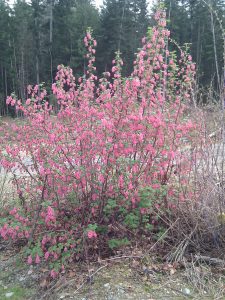 The wild red flowering currant is native to BC and also a very popular shrub in England. My husband and I moved to the Cowichan Valley this winter and I have been enjoying just getting to know my new neighbourhood. Imagine my delight in coming across this beautiful flowering shrub on in the woods near my new home.
The wild red flowering currant is native to BC and also a very popular shrub in England. My husband and I moved to the Cowichan Valley this winter and I have been enjoying just getting to know my new neighbourhood. Imagine my delight in coming across this beautiful flowering shrub on in the woods near my new home.
I had never seen it before and set about to find out what it was. It is a wild Flowering Red Currant (Ribes sanguineum), a member of the gooseberry family, and apparently very popular with native plant gardeners. You can see why! The flowers are spectacular perfect pink flowers, tubular-shaped, in fragrant drooping clusters of 10–20 flowers and the blooms last for quite a long time from March to May. I immediately wanted it for my yard. Whenever I visited the bush, it was just buzzing with bees. It is also known for attracting humming birds[i].
It is a deciduous plant found along the coast in the Pacific Northwest. Sightings are common on lower Vancouver Island and coastal areas of the lower mainland and all the way to California. It is occasionally found in scattered localities in the interior of the province. It prefers maritime to submaritime cool mesothermal climates and thrives on very dry to moderately dry, nitrogen-medium soils.[ii]
According to Wild Food blogger, T. Abe Lloyd, the first botanical specimen of Red Flowering Currant was collected by Archibald Menzies, naturalist on Captain Vancouver’s 1792 voyage in the Pacific Northwest. Explorer-botanist David Douglas made it one of the most popular flowering shrubs in England. He collected seeds in late July or early August of 1825 on a trip to Fort Vancouver, Washington which he shipped back to his employer, the London Horticultural Society. [iii] (a little side note – the Douglas fir so common in BC forests is named after him)
First Nations peoples knew the red-flowering currant mainly as a food plant. The Coast Salish peoples collected and sometimes ate the fruit raw or mixed with other berries. In the Fraser Canyon, The Nlaka’pamux (Thompson) peoples dried and stored the berries for eating later in the year when they were stewed or added for flavor to other foods such as soup. [iv]. The Halkomelem believed that if the flowers were picked it would rain[v].
According to Boucher (1992)[vi] flowering red currant propagates easily. Just stick a stem in the ground and it will root. Hebda (2002) suggests the easiest way to propagate the red-flowering currant is by layering. Simply bend the straggly stems to the ground, cover with a little soil and weigh down with a rock. Within a year the stems will have rooted and can be cut away from the parent and planted out. I might just try one of these methods. It is supposed to be very fast growing.
The berries which are grey-blue, unlike other red currants that appear in the summer. I’ll keep watching and report on the berries in a later post.
[i] Hebda, Richard, (2002). Red-Flowering Currant, BC Living. https://www.bcliving.ca/red-flowering-currant
[ii] Klinkenberg, Brian. (Editor) 2017. E-Flora BC: Electronic Atlas of the Plants of British Columbia [eflora.bc.ca]. Lab for Advanced Spatial Analysis, Department of Geography, University of British Columbia, Vancouver
[iii] http://arcadianabe.blogspot.ca/2013/07/the-news-on-red-flowering-currant.html
[iv] Hebda, Richard, (2002). Red-Flowering Currant, BC Living. https://www.bcliving.ca/red-flowering-currant; Kuhnlein, H. V., & Turner, N. J. (1991). Traditional plant foods of Canadian indigenous peoples: nutrition, botany, and use (Vol. 8). Taylor & Francis.
[v] Turner, N. (2014) Ancient Pathways, Ancestral Knowledge: Ethnobotany and Ecological Wisdom of Indigenous Peoples of Northwestern North America, McGill-Queen’s Press, p. 308.
[vi] Boucher, J. (1992). Red-flowering and Other Currents. in Turner, N.J.
(1992). Plants for All Reasons: Culturally Important Plants of the Aboriginal Peoples of Southern Vancouver Island. Environmental Studies Program. University of Victoria, B.C
